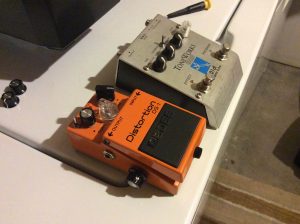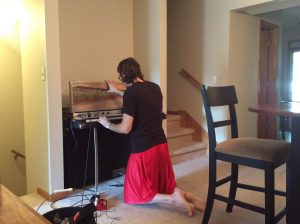Finished a couple of small soldering jobs this weekend.
The DS-1 (orange guy) is my very first pedal. Cole had added the Casper Electronics gated feedback mod a year or two ago; I swapped in a different transistor, changed the switching to a different leg of the transistor for quieter operation when the feedback is off, and added a “chaos” control (the knob on the side of the pedal) that can tame the feedback a little when it’s on. This transistor oscillates with the distortion all the way up; rolling back the chaos control can change the pitch of or eliminate the oscillation.
The Korg 301dl just had a broken pot; simple, though it was kind of a bear to replace. I couldn’t find a replacement pot with the same shaft as the original to accommodate the original knob so it got that clear one, which turned out to be easier to use anyway.
The DS-1 will go onto my Mars Lights board for the time being, until I finish the super ultimate modded DS-1 that’s currently in pieces.
The Korg will just hang around at home, which will be handy for times when my big board is at Drew’s. It has a cool feature set including two presets, separate high and low frequency damping on the repeats, a hi-fi / lo-fi blend, and a weird ducking control.
What’s strange is that the ducking isn’t very interactive with the input signal; it’s more like another kind of pre-delay and the control sets the amount of time it takes the delay signal to come up to its full level. That means that with the ducking maximized, if you hit a staccato note, you hear a bit of silence and then the delay fades in. The ducking I’m used to from recording and the TimeFactor is more like a compression ratio, and would fade the echo in immediately as the the input signal dropped on a staccato note.
It doesn’t self-oscillate at maximum feedback level, which is OK – I have the DE7 for that – and can make for nice ambient pad sounds.
I’d like this pedal a lot more if the delays spilled over from one preset to the other. It could actually back up my TimeFactor in a limited way if it did that, but we have songs – Nein, Stangray, Radio Edit – where I need an echo with a lot of feedback that spills over on bypass or when the preset changes.
I guess with the A/B box I plan to build and any two delays (like the DE7 and 301dl) I could back up the TimeFactor somewhat. Maybe I need two A/B boxes?



